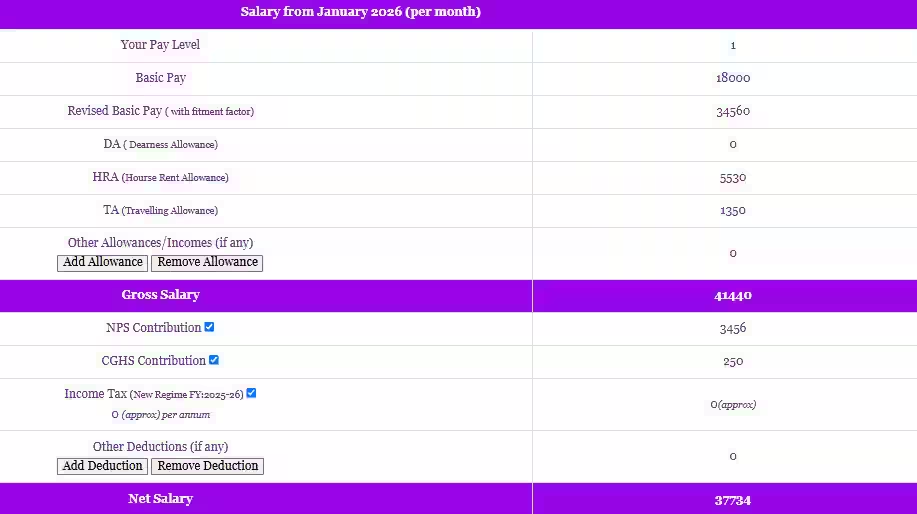How much will your salary increase from the 8th Pay Commission? Know what is the new pay matrix, what can be the fitment factor, and how big will be the jump in the basic salary of employees from level-1 to level-18. Understand every small and big information related to the 8th Pay Commission here.
The countdown for the biggest news ever for crores of central employees and pensioners of the country has started. The 8th Pay Commission is no longer just a topic of discussion, but is on its way to becoming a reality. This commission will not only bring a bumper jump in your salary, but will also give a new shape to the entire structure of your allowances, pension and career growth.
But you will also have the same questions in your mind that every employee has in his mind – how much will my salary actually increase? What will the new pay matrix look like? What will be the fitment factor this time? And most importantly, when will all this be implemented?
Let us answer all your questions related to the 8th Pay Commission today.
8th Pay Commission Key Highlights
| Features | Description |
| Objective | Revision of pay, allowances and pension of Central Government employees and pensioners |
| Date of establishment | January 16, 2025 |
| expected to be implemented | January 1, 2026 |
| Beneficiaries | About 50 lakh central employees and 65 lakh pensioners |
| Main factors | Review of existing pay structure, adjustment in allowances, revision of pension, change in fitment factor |
| Estimated Fitment Factor | Between 1.83 and 2.46 (some reports suggest up to 2.86) |
| Dearness Allowance (DA) | will reset to zero as soon as applicable |
What is 8th Pay Commission and why is it so important?
The 8th Pay Commission is a panel to be formed by the government, which will assess the current salary structure of central employees. Its main job is to balance government salaries with rising inflation, cost of living and comparison to the private sector.
How has the salary structure changed?
- 6th Pay Commission: It introduced the system of ‘Pay Bands’ and ‘Grade Pay’.
- 7th Pay Commission: It abolished the grade pay system and introduced a simple and transparent ‘pay matrix’ in which salaries are determined based on levels.
- 8th Pay Commission: It is expected that this will bring a big increase in the salary through the fitment factor, based on the pay matrix of the 7th Pay Commission.
Latest Updates on 8th Pay Commission
According to reports, the implementation of the 8th Pay Commission can increase the salary and pension of employees by 30-34%. This is expected to put an additional burden of about Rs 1.8 lakh crore on the central government treasury. There is also a heated discussion about the fitment factor, which is likely to be between 1.83 to 2.46. The most likely figure is 1.90-1.92.
When will we get the gift of increased salary?
According to the pattern of every 10 years, the 8th Pay Commission is expected to be effective from January 1, 2026. The government had expressed the possibility of this happening with its announcement. Even though it may take some time for its recommendations to come and cabinet approval, it can be implemented from the previous date (January 1, 2026) and employees will get full arrears.
The biggest question: What will the pay matrix of 8th Pay Commission look like?
It is difficult to predict the exact hike, but experts believe that the basic salary could increase between 18% and 35%. If we assume a general hike of 20%, the comparative pay matrix of the 7th and 8th Pay Commission could look something like this:
| Pay Matrix Level | Basic Salary of 7th CPC | Estimated Basic Salary of 8th CPC (with 20% hike) |
| Level 1 | ₹18,000 | ₹21,600 |
| level 2 | ₹19,900 | ₹23,880 |
| Level 3 | ₹21,700 | ₹26,040 |
| Level 4 | ₹25,500 | ₹30,600 |
| Level 5 | ₹29,200 | ₹35,040 |
| Level 6 | ₹35,400 | ₹42,480 |
| Level 7 | ₹44,900 | ₹53,880 |
| Level 8 | ₹47,600 | ₹57,120 |
| Level 9 | ₹53,100 | ₹63,720 |
| Level 10 | ₹56,100 | ₹67,320 |
| Level 11 | ₹67,700 | ₹81,240 |
| Level 12 | ₹78,800 | ₹94,560 |
| Level 13 | ₹1,23,100 | ₹1,47,720 |
| Level 13A | ₹1,31,100 | ₹1,57,320 |
| Level 14 | ₹1,44,200 | ₹1,73,040 |
| Level 15 | ₹1,82,200 | ₹2,18,400 |
| Level 16 | ₹2,05,400 | ₹2,46,480 |
| Level 17 | ₹2,25,000 | ₹2,70,000 |
| Level 18 | ₹2,50,000 | ₹3,00,000 |
What can be the salary after applying the Fitment Factor?
| Pay Level | 7th Pay Commission (Basic Pay) | 1.92 fitment factor | 2.08 Fitment Factor | 2.86 fitment factor |
|---|---|---|---|---|
| Level 1 | ₹18,000 | ₹34,560 | ₹37,440 | ₹51,480 |
| Level 2 | ₹19,900 | ₹38,208 | ₹41,392 | ₹56,914 |
| Level 3 | ₹21,700 | ₹41,664 | ₹45,136 | ₹62,062 |
| Level 4 | ₹25,500 | ₹48,960 | ₹53,040 | ₹72,930 |
| Level 5 | ₹29,200 | ₹56,064 | ₹60,736 | ₹83,512 |
| Level 6 | ₹35,400 | ₹67,968 | ₹73,632 | ₹1,01,244 |
| Level 7 | ₹44,900 | ₹86,208 | ₹93,392 | ₹1,28,414 |
| Level 8 | ₹47,600 | ₹91,392 | ₹99,008 | ₹1,36,136 |
| Level 9 | ₹53,100 | ₹1,01,952 | ₹1,10,448 | ₹1,51,866 |
| Level 10 | ₹56,100 | ₹1,07,712 | ₹1,16,688 | ₹1,60,446 |
Now understand the calculation
In the 8th Pay Commission also, calculation has been done on the lowest grade.
- Level-1 grade pay 1800, the basic pay in this grade is Rs 18000. After this, the fitment factor in it is considered to be 1.92.
- HRA has been taken according to Y category. It is also easy to make revisions in it. Therefore it has been kept at 16%.
- Travel Allowance (TA) is calculated as per higher TPTA city.
- If you see, the total gross salary is Rs 41440. But, this will not be the final salary.
- Government employees will also have to pay NPS contribution and CGHS contribution.
- After salary revision, contribution to NPS will be Rs 3456 and Rs 250 will go to CGHS.
- The net salary on one grade-pay will be Rs 37734.
- In this, dearness allowance i.e. DA has been kept zero. Because, it will be made zero when the new pay commission is implemented.

Focus areas of 8th pay commission
Restructuring of Pay and Allowances
The commission will revise the entire pay structure. Apart from this, the MACP (Modified Assured Career Progression) scheme is also expected to be improved, so that an employee can get at least five promotions in his entire career.
DA and interim relief
When the commission comes into force, the existing DA (which is currently 55%) will be merged into the basic salary and made zero. Employee organizations are also demanding an interim relief until the new recommendations are implemented.
Estimated Salary Hike
As mentioned earlier, the entire game of salary hike will depend on the fitment factor. According to reports, it can increase from 2.57 to 2.86.
Conclusion
The 8th Pay Commission is bringing the promise of not just a pay hike but a better financial future for central government employees and pensioners. The commission will aim to design a fair and attractive compensation package keeping in mind today’s inflation and cost of living. While the final recommendations are yet to come, the potential pay hike and policy changes are sure to have a huge and positive impact on lakhs of government officials and pensioners.
Frequently Asked Questions (FAQs)
Q1: When will the 8th Pay Commission be implemented?
A: It is likely to be implemented from January 1, 2026.
Q2: What is fitment factor?
A: This is a multiplier by which the existing basic pay is multiplied to determine the new basic pay.
Q3: What can be the minimum salary in 8th Pay Commission?
A: With a 20% increase it could become ₹21,600, but if the fitment factor is higher then it could go up even further.
Q4: Will DA become zero in the new pay commission?
A: Yes, DA will be merged into the new basic salary and reset to zero.
Q5: What changes can be made in the MACP scheme?
A: This can be improved by making a provision to give at least five promotions to an employee in his entire career.




